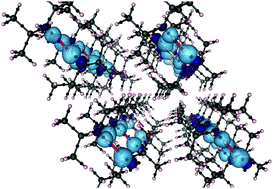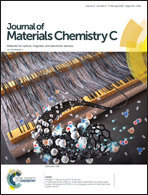Polarization canting in ferroelectric diisopropylammonium-halide molecular crystals: a computational first principles study†
Abstract
We report the results of a computational first-principles study of the structural and electrical properties of three ferroelectric diisopropylammonium halides containing chlorine, bromine, and iodine. Calculations were carried out using density-functional theory with maximally-localized Wannier functions utilized for computing electrical polarization within the Modern Theory of Polarization formalism. For each of the crystals, the polar properties for all of the relevant polymorphs were evaluated and decomposed into contributions from individual positive diisopropylammonium and negative halogen-ion charge centers. The calculations show that each diisopropylammonium-halide unit in the crystal possesses a substantial dipole moment with magnitude of 10 to 15 Debye, but that these dipoles are arranged in a mutually opposing manner, leading to full cancellation in the paraelectric phase. In the ferroelectric phase, the dipoles cant along a common polar axis, inducing a small net dipole moment in the crystallographic unit cell, with spontaneous polarization ranging from 5 μC cm−2 for the iodide to 6 μC cm−2 for the bromide and 7 μC cm−2 for the chloride, suggesting no strong dependence of the polarization on the chemical identity of the halide counter ion. We propose that structural modifications of the diisopropylammonium-halide system aimed at stabilization of large unit-dipole cantings could produce molecular crystals with greatly increased spontaneous polarization.



 Please wait while we load your content...
Please wait while we load your content...